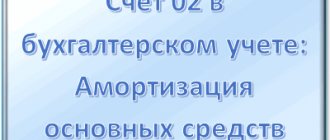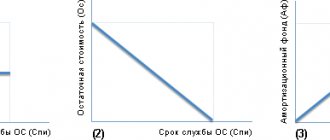Depreciation is the reduction in the value of assets due to wear and tear. The calculation of this indicator is of great importance for accounting and tax accounting. The time of write-off of fixed assets, the amount of taxes paid and other parameters depend on such an operation.
The rate of depreciation is determined by the conditions under which fixed assets are used and how exactly they are operated. In some cases, taxpayers have the right to write off assets in a shorter period, using so-called accelerated depreciation.
Essence and concept
Accelerated depreciation is based on the principles of straight-line A. This means that all write-offs are equal, but their value is higher than in the case of straight-line depreciation. Fixed assets are calculated in a shorter period of time.
The essence of accelerated depreciation is as follows: entrepreneurs can shorten period A by applying increased rates. Of course, this is only possible after certain requirements are met, such as the use of fixed assets in conditions that indicate rapid consumption or in which rapid technological progress is observed.
It is preferable to use increased depreciation rates for buildings, vehicles and equipment subject to increased wear and tear. The legislation contains detailed instructions regarding the possibility of applying higher standards A.
Accelerated depreciation increases the amount of write-offs from fixed assets, while reducing the term A and the amount of taxes.
Application of increasing coefficients for operating systems operating in an aggressive environment
The use of an increased depreciation rate is permissible when operating the OS in an aggressive environment, with increased shifts. The increase is no more than 2. The date of registration of the OS must be no later than 01/01/2014. The use of such a norm is prohibited for fixed assets of the 1st, 2nd and 3rd depreciation groups when using the non-linear method.
An aggressive environment is understood as natural or man-made environmental factors that accelerate the deterioration of fixed assets (paragraph 3, subparagraph 1, paragraph 1, article 259.3 of the Tax Code of the Russian Federation):
- climatic conditions of the Far North;
- contact of OS with explosive or toxic materials, etc.
According to officials, increasing coefficients can be used if the following requirements are met:
- the accompanying documentation does not indicate that they are intended to work in an aggressive environment;
- If there is such a mention, then you can use the benefit if the operating conditions do not correspond to those specified in the documents attached to the asset.
The Ministry of Finance believes that if the documents indicate the possibility of working in an aggressive environment, then the use of accelerated depreciation is not justified.
Judges, on the contrary, point out that the very fact of the presence of an aggressive environment is sufficient to apply increasing coefficients (Resolution of the Federal Antimonopoly Service of the Volga District dated February 13, 2014 No. A65-9516/2013).
The application of coefficients applies only to objects exposed to an aggressive environment. The remaining fixed assets of the enterprise, if they are under normal operating conditions, cannot be depreciated faster (letter of the Ministry of Finance of Russia dated October 14, 2009 No. 03-03-05/182, Federal Tax Service of Russia dated November 17, 2009 No. ShS-17-3 / [email protected] ).
What is it used for?
It is important to note that accelerated depreciation can be applied to all types of fixed assets. The entrepreneur has the right to increase the rates arising from the list of norms A, using the appropriate coefficients for:
- buildings and structures used in deteriorated or poor conditions;
- machines, devices and vehicles (except for the marine fleet) used more intensively than in average conditions or requiring special technical efficiency;
- machines and equipment that are subject to rapid technological progress.
All the main conditions for the use of this method are listed in Art. 259.3 Tax Code of the Russian Federation.
Depreciation of fixed assets involved in scientific and technical activities
Accelerated depreciation is provided for all enterprises in terms of the use of fixed assets for scientific and technical activities. The size of the coefficient should not exceed 3 (subclause 2, clause 2, article 259.3 of the Tax Code of the Russian Federation).
Scientific and technical activities are understood as activities aimed at obtaining new knowledge in any branch of science while ensuring the unity of science, technology and production. (Article 2 of the Law “On Science and State Scientific and Technical Policy” dated August 23, 1996 No. 127-FZ).
The Ministry of Finance notes that this category also includes research and development activities (letter dated August 28, 2009 No. 03-03-06/1/554).
Conditions of use
Accelerated depreciation is the transfer of asset cost to product cost at an accelerated rate.
Since such deductions are accepted as expenses for income tax, tax regulations strictly regulate the issue of accelerated write-off.
When depreciating an asset using the accelerated method, it is allowed to apply one increase in depreciation from among the possible ones. The ban on the introduction of several coefficients was previously contained only in letters from the Ministry of Finance, but as of January 1. In 2014, it was enshrined in clause 259.3 of the Tax Code of the Russian Federation.
The taxpayer must indicate in the accounting policy what acceptable indicator will be used to calculate A at the rate.
The main prerequisites for using this type of accelerated depreciation:
- there is an urgent need to quickly write off an object;
- with increased equipment load at the very beginning of activity;
- if such objects include: electronic equipment, quickly becoming obsolete models;
- when regulating the load on a non-current asset;
- problems with writing off funds.
Results
By writing off depreciation using the accelerated method, the taxpayer reduces the tax base for income tax. And since, according to Art. 252 of the Tax Code of the Russian Federation, all expenses must be economically justified and documented; the taxpayer should be very careful about the issue of writing off depreciation at an accelerated pace.
Sources:
- Tax Code of the Russian Federation
- PBU 6/01, approved. by order of the Ministry of Finance of Russia dated March 30, 2001 N 26n
You can find more complete information on the topic in ConsultantPlus. Free trial access to the system for 2 days.
Situations for using the method
List of situations allowing the use of accelerated depreciation rates:
- Aggressive environment conditions. The introduction of the coefficient is assigned to OSs that are operated in conditions of high environmental aggressiveness. The increase in coefficient A is no more than 2.
- Conducting agricultural production work provides for accelerated depreciation of all fixed assets. The increase in the coefficient is no more than 2.
- The company's work in an industrial-production or tourist-recreational zone gives the right to use a coefficient within 2 for all fixed assets used in the work.
- For objects on the balance sheet of the lessor (lessee) OS - coefficient 3.
- Application for offshore hydrocarbon production. The right to this depreciation within a coefficient of no more than 3 is provided for companies that have a license for this activity and offshore oil production operators. This exception applies to equipment that is used to develop a new mine.
- From 01/01/2008, depreciation of 3 times is applied to water supply and sewerage assets in the list that was approved by the Cabinet of Ministers of Russia.
The Tax Code does not prohibit the introduction of several coefficients for different groups of fixed assets. Aspects of the introduction of ratios must be specified in the company's accounting policies.
Highlights ↑
There are two depreciation methods. In the first case, depreciation is charged in equal parts over a certain period. In the second case, accelerated depreciation is used. Let's consider what its essence is and what its functions are.
Required terms
Wear and tear is the decrease in the primary price of objects when worn out in the production process or due to obsolescence. Depreciation is reflected every month in depreciation charges.
Depreciation is the gradual wear and tear of an object and the transfer of their price evenly to the goods produced. The accrued depreciation amount is included in the cost of the goods that are produced, or distribution costs.
They create depreciation funds that are used during restoration work. A common technique that provides faster tax credits on assets is accelerated depreciation.
With its help, owners can receive more income to offset costs at certain stages of enterprise development.
The use of specific forms of depreciation is based on the search for ways to reduce the tax burden on the company. Accelerated depreciation is called depreciation at an inflated rate, when an increase in the rate is permissible no more than 2 times.
That is, most of the asset price is written off as expenses in the first years of using the assets, and this will allow managers to reduce the tax deduction on profits.
Direct depreciation mechanisms are not used here. But it will also impact your ability to claim depreciation on assets in the coming years.
Functions performed
The purpose of depreciation is to distribute the price of tangible assets that are used for a long time to costs over the operating period.
The basis is the use of systematic and rational records. There is a procedure of distribution, not evaluation. Accelerated depreciation allows you to stimulate the pace of development of the industrial sector.
In Excel, when calculating accelerated depreciation charges, the following functions are used:
| ASCH | Can return the amount of depreciation of assets over a certain period, which is calculated based on the amounts of the useful life period |
| FOO | Can return the amount of depreciable assets for given periods, which is calculated by recording the decrease in the residual amount |
| DDOB | Can return the depreciation rate of assets for given periods using double-decrease-residual methods, etc. |
The legislative framework
When determining depreciation charges, you should be guided by the following regulations:
| PBU for OS accounting | What was approved by Order No. 65n of September 3, 1997 |
| Federal Law of July 23, 1998 No. 123 | Which amended the accounting law |
| Federal Law No. 164 | Applicable for leasing |
| Federal Law No. 129 of November 21, 1996 | About accounting |
Calculation formula
In accounting, this method is also called the reducing balance method, where the application is based on the residual value of the asset, the acceleration factor and the useful life itself.
The accelerated depreciation formula looks like this:
A = St / SPI * K,
where A is the amount of depreciation charges, t. rub.;
St – residual value of the asset at the beginning of the year, t. rub.;
SPI – time of use of the asset, years;
K – acceleration coefficient. The maximum value is 3. For small enterprises - no higher than 2.
Why does an entrepreneur need to know how to calculate depreciation of equipment?
Firstly, taking into account depreciation will allow you to understand the feasibility of purchasing a particular type of equipment. Will the company be able to bear the costs associated with its acquisition?
Secondly, the correctly chosen method of depreciation deductions is the main source of optimization of an enterprise’s expenses and its tax obligations.
Thirdly, the success of the financial, economic and production indicators of the enterprise generally depends on the correct calculation of deductions for equipment depreciation
Odds
The acceleration rate is a statutory fixed rate used to calculate the accelerated depreciation of fixed assets when a company has a basis.
This indicator varied from 2 to 3.
Using this indicator, the manufacturer includes the cost of depreciation of the operating system in the final price of the product, taking into account the multiplication by this indicator.
At the end, these amounts are reflected in the final cost of production in the direction of growth, which helps to compensate for equipment costs and reduce the amount of tax payments.
Factors that increase the value of depreciation write-offs used on this basis can be a maximum of:
- 1.2 in the case of buildings and structures used in deteriorated conditions;
- 1.4 in the case of buildings and structures used in poor conditions and the above-mentioned devices and vehicles;
- 2.0 for machines and equipment of groups 4-6.
What is important is that the coefficient applied by the entrepreneur should not reach the maximum amount specified in the regulations. However, it is worth remembering that choosing the highest possible ratio leads to the maximum reduction in the depreciation period.
Depreciation after modernization: tax aspect
To determine the work related to current, medium and major repairs, you can refer to the Guidelines for accounting of fixed assets (approved by order of the Ministry of Finance of Russia dated July 20, 1998 No. 33n; hereinafter referred to as guidelines). Although this document was developed on the basis of the canceled PBU 6/97 “Accounting for fixed assets” (approved by order of the Ministry of Finance of Russia dated 09/03/97 No. 65n), it can be used to the extent that does not contradict the currently valid PBU 6/01 “Accounting for fixed assets” (approved by order of the Ministry of Finance of Russia dated March 30, 01 No. 26n). Work on routine and medium repairs of fixed assets includes work to systematically and timely protect them from premature wear and maintain them in working order during their useful life (clause 71 of the guidelines). During major repairs of buildings and structures, worn-out structures and parts are replaced or replaced with more durable and economical ones that improve the operational capabilities of the objects being repaired, with the exception of the complete replacement of the main structures, the service life of which in a given object is the longest (stone and concrete foundations of buildings, pipes underground networks, etc.).





